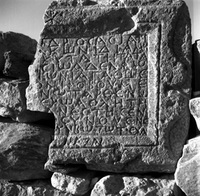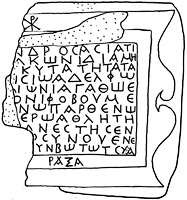 MAMA XI 292 (Northern Lykaonia)
MAMA XI 292 (Northern Lykaonia) 
Sarcophagus set up by Alexandros, deacon, for his brother
- Type of monument:
- Sarcophagus fragment.
- Location:
- Maydos (Northern Lykaonia): in the wall of the cemetery.
- Description:
- Grey marble fragment of a sarcophagus, broken left, right and below, with inscription in tabula ansata.
- Dimensions:
- Ht. 0.48+; W. 0.45+; Th. 0.14; letters 0.017-0.022.
- Record:
- Line drawing; MB notebook copy; photograph (1956/151).
- Publication:
- Thonemann 2011b: 198-200, no. 2.
- Date:
- Fourth century AD.
☧
[Ἀλέξα]νδρος Ἀσιατι-
[κοῦ δι]άκων ἰδίᾳ μη-
[τρὶ γλυ]κυτάτῃ Τατᾳ
5[καὶ γν]η̣σίῳ ἀδελφῷ
[- - - -]ίωνι ἀγαθῷ ἐ-
[χέφρ]ονι φοβουμέ-
[νῳ ἁγ]νῷ παρθένῳ
[κρατ]ερῷ ἀθλητῇ
10[τοῦ] Χ(ριστο)ῦ ἀνέστησεν
[μνημ]οσύνου ἕνε-
[κεν, ἐπὶ τ]ύνβῳ τ᾿ ᾧτ᾿ ἐχά-
[ vac. ] ραξα.
Alexandros, son of Asiatikos, deacon, set this up as a memorial for his own sweetest mother Tata, and for his legitimate brother ...ion, a good man, prudent, reverent, a holy virgin, a strong athlete of Christ; I inscribed (it) on this tomb.





The village of Maydos lies some 5km to the north-east of Zıvarık/Altınekin, around 2km to the east of the road connecting Altınekin with Hoydus/Akıncılar.
For the name Ἀσιατικός, cf. Anderson 1899: 281, no. 164 (Zıvarık/Altınekin); Cronin 1902: 354, no. 100 (Konya: Αὐρ. Ασιατική); perhaps MAMA XI 317 (1956/189: Bayramdüğün). In line 4, Alexandros describes his brother as γνήσιος, ‘legitimate’. This may be intended to indicate that they are blood-relatives, and not (merely) spiritual brothers (cf. MAMA XI 302 [1957/52]); for this usage of the term γνήσιος, compare I.Smyrna 563 (Θεοδώρῳ τῷ ἐμῷ γνησ(ίῳ) ἐκγόνῳ καὶ πνευματικῷ υἱῷ). However, the term is regularly found in the funerary epigraphy of the villages of the Axylon simply as a term of affection, ‘dear’ (Robert, Hellenica XIII, 218-22: e.g. MAMA I 358, 361, 365; MAMA VII 427, 565, 585; RECAM II 238, 354).
The sequence of epithets applied to Alexandros’ brother has no close parallels in the Christian epigraphy of Lykaonia. The term ἐχέφρων (if correctly restored here) is also found in MAMA I 229-30 (Laodikeia), ἀθάνατος δὲ θεὸς ἐχέφρονα εἵλατο δοῦλον. The term ἁγνός is regularly used of members of the clergy in this region: MAMA VIII 280 (Obruk), Δόμνῳ ἁγνῷ δειάκονι; MAMA I 196 (Kadınhanı), ἁγνὸ̣ς̣ π[ρ]ε̣σ̣β̣(ύτερος); Laminger-Pascher 1992: 231, no. 410 (Aydoğmuş/Dorla: Isauropolis), ὁ ἁγνότατος... ἐπίσκοπος. I can find no other epigraphical instance of the term φοβούμενος standing alone; it should presumably be taken simply to mean ‘reverent’ (Luke 1:50, 18:2; Acts 10:35) rather than in the technical sense of ‘God-fearer’ (Acts 10:2, 22; 13:16, 26; Reynolds and Tannenbaum 1987: 48-66). The description of Alexandros’ brother as a ‘strong athlete of Christ’ is particularly striking, since the phrase ἀθλητὴς τοῦ Χριστοῦ is normally used only with reference to martyrs: Calder 1920: 52-3, 58-9; Mitchell 1982: 100-1. However, the phrase is given no particular prominence or emphasis in this inscription, and it seems more likely that it is here used in a weak sense of ‘one who fought for his persecuted faith’, probably against Orthodox oppressors; cf. Wilhelm 1932: 845-6, on the term ἀθλοφόρος in MAMA I 171. Cf. also MAMA XI 288 (1956/135: Zengicek [Koçyaka]).
For another (female) ‘holy virgin’ in this region, cf. MAMA XI 337 (1956/164: Koçaş). However, the use of the term παρθένος for a man (line 7) is highly striking and unusual, and strongly suggests that Alexandros and his brother were members of one of the ascetic sects which flourished in Lykaonia in the fourth century AD: see Thonemann 2011b. These sects were outlawed in the early 380s AD (CTh 16.5.7.3 [May 381]; 16.5.9.1 [March 382]; 16.5.11 [July 383]); the fact that the inscription does not name the ascetic group to which Alexandros and his brother belonged, but appears to hint that the deceased man was persecuted for his faith (see above), may suggest that the inscription postdates the imperial legislation.
For the formula in lines 11-12, cf. MAMA VIII 320 (Sadaettin Hanı), ζῶν γὰρ ἀνέστησ[εν] ἐπὶ τύνβῳ τ᾿ ὧδ᾿ ἐκάραξεν. On this parallel, I have assumed, with some misgivings, that the letters ΤΩΤ in line 11 represent τ᾿ ὧτ(ε), i.e. ὧδ(ε). For funerary inscriptions which record their own inscribing, cf. MAMA XI 287 (1956/130).